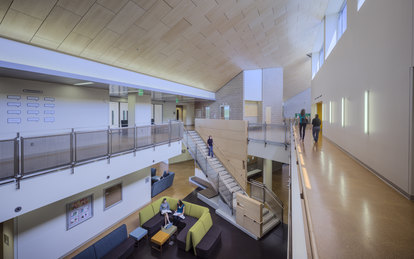The Human Health Building: Where Students Learn How to Keep People Healthy

As SmithGroup celebrates reaching our 100th LEED certified project, sustainability leaders recall working on some of the LEED certified projects that have helped us become one of the leading sustainable design firms in the U.S. In this blog post, Chris Purdy tells of some of the keys to success of the Oakland University Human Health Building, the first LEED Platinum university building in Michigan.
When I think about the Human Health Building (HHB), the intrinsic connection between human health and our environment immediately comes to mind. What better place to realize the benefits of sustainable design than in a facility that is focused entirely on educating health professionals?
Right from the start, Oakland University had a clear vision for the new human health building. Its primary purpose was to bring together two growing schools – Nursing and Health Sciences – into one place where future nurses, physical therapists, occupational therapists would trained together. It would establish the new “Human Health Quad” in an area of campus that had not been built upon previously. And, it was to be an exemplary building for sustainable design.
Walking through the building today, it is rewarding for me to look back on the design process and see how this holistic, sustainable vision has manifest itself in the architecture in several tangible and meaningful ways. Some examples:
Connectivity with the site: The building footprint embraces an enhanced wetland area, and a significant oak tree as it provides an inviting gathering space on the south side of the building. Additionally, the ground beneath an existing parking area is put to good use as a 256 well geothermal field.
Sense of Community: I love to see both nursing and health science students hanging together out in the “living room” spaces on the fourth and fifth floors. Student space is often assigned to lower floors of academic buildings, but here, we moved the student space to the top in order to allow the sense of community grow out of the student’s interactions with one another. These spaces have abundant natural light, a warm and natural material palette including cork and exposed face concrete masonry. The “living room” spaces enable a sense of well-being, connectivity and comfort that goes hand-in-hand with an environmental sound approach.
Efficiency of space use: The notion that 1 + 1 = 3 is embodied within the building. Emphasizing shared space provides opportunities for inter-professional collaboration as well as good stewardship of resources. As a result, the building footprint is able to be more compact while a flexible, multi-functional planning strategy will help make the building sustainable over time – allowing it to adapt and change as the schools grow and evolve.
Visibility of Technology: I don’t know of many rooftops that are a highlight of any building tour, but that is definitely the case at the Human Health Building. One of the systems featured on the rooftop tour is the 100 roof-mounted solar panels that provide approximately 40% of the building’s heating hot water load. A $2.7 million grant from the U.S. Department of Energy enabled this system to be added to the project scope during the design phase.
Receiving LEED Platinum certification was a significant team effort on the part of Oakland University, The Christman Company (CM) and SmithGroup…and a source of great pride for all of us. For me, the real reward comes from seeing how well the building has become an ideal, sustainable place for students to learn how to keep people healthy!